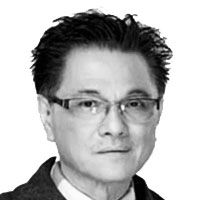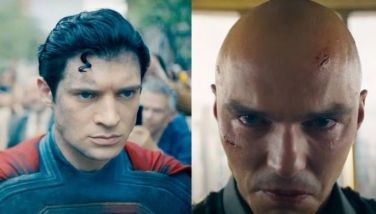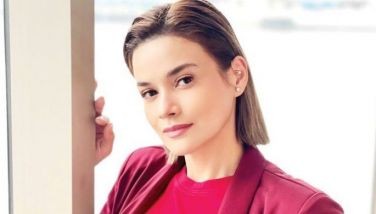Cesar's Conquest

August 7, 2005 | 12:00am
 Hundreds showed up for the auditions of The Great Raid, but only a handful was chosen, led by Cesar Montano who bagged the coveted role as USAFFE guerilla leader Capt. Juan Pajota – that is, "coveted" by the Filipino actors who auditioned, including Cesar’s younger brother Rommel Montano, Ryan Eigenmann, Alvin Anson, Mars Cavestany, Ebong Joson and RJ Leyran who died last year. All of them, plus US-based Paolo Montalban who is cast as an American scout, made it to the movie,
Hundreds showed up for the auditions of The Great Raid, but only a handful was chosen, led by Cesar Montano who bagged the coveted role as USAFFE guerilla leader Capt. Juan Pajota – that is, "coveted" by the Filipino actors who auditioned, including Cesar’s younger brother Rommel Montano, Ryan Eigenmann, Alvin Anson, Mars Cavestany, Ebong Joson and RJ Leyran who died last year. All of them, plus US-based Paolo Montalban who is cast as an American scout, made it to the movie,
Directed by John Dahl (The Last Seduction, Rounders, etc.) and produced by Marty Katz (who was the supervising producer of Titanic), The Great Raid is based on the books The Great Raid on Cabanatuan by acclaimed military historian William B. Breuer and Ghost Soldiers by Hampton Sides.
According to the production notes, The Great Raid was once a tale shared across the US, a long-lost story that actually happened in 1945 when hundreds of US soldiers were held captive in the brutal Japanese war camp in Cabanatuan, Nueva Ecija, under imminent threat of death. They were the only soldiers who remained alive in the Philippines after most of the 70,000 American and Allied Forces surrendered to the Japanese Imperial Army in Bataan in 1942 following the departure of Gen. Arthur MacArthur. Forced to walk through the sweltering, mosquito-infested jungles on what would become known as the Bataan Death March, the survivors were then held captive in remote and deadly camps. Three years later, with MacArthur back in the Philippines, the Japanese War Ministry had issued a "Kill All Policy" to annihilate their war camps, and every US prisoner in them. The Great Raid on Cabanatuan (and Ghost Soldiers) chronicle how the POWs were rescued with the help of Filipino guerillas.
While Capt. Robert Prince was the brains and Lt. Col. Henry Mucci the one behind the Cabanatuan rescue mission, it was Capt. Pajota who provided vital keys to the mission because he knew the land, had the trust of local villagers and commanded the local guerilla forces.
Cesar bagged the role as Capt. Pajota with ease, what with his rugged looks, vast acting ability and physical resemblance to the USAFFE guerilla leader. Cast in the lead role as Lt. Col. Henry Mucci is Benjamin Bratt (one-time boyfriend of Julia Roberts); with James Franco (who played the title role in the telemovie The James Dean Story and the villain to Toby Maguire in Spider-Man 1 and 2) as Capt. Robert Prince, the 25-year-old Stanford graduate who planned the rescue mission under Mucci; Joseph Fiennes (Shakespeare in Love, etc.) as the wearied but unrelentingly hopeful POW Major Gibson; and Connie Nielsen (Gladiator, etc.) as Margaret Utinsky, Major Gibson’s lost love.
After a little hitch (no, it didn’t go straight to video, contrary to earlier rumors), The Great Raid was finally premiered on July 28 in Washington D.C., with the event graced by such US dignitaries as Senators Hillary Clinton and John MacCain. Cesar attended the premiere. He came back Thursday.
"I couldn’t believe it was happening," recalled Cesar about the event. "It was like a dream."
The movie opens in Manila on Wednesday, Aug. 10, two days before the playdate in theaters across America.
With his American Dream well within reach, Cesar plans to stay in L.A. for the meantime, hoping that The Great Raid will lead to something good, something big. Hollywood, here Cesar comes?
In the following Conversation, Cesar shares his experiences and memories on the set of The Great Raid in Australia (other scenes were shot in Shanghai).
How did you prepare for your role?
"I read the script earlier. During the reading, I was asked to deliver the lines of Pajota from the script. A copy of my movie, Muro-Ami, was sent to the casting director in New York. When I was taken in, they gave me a maleta full of reading materials, including videotapes, the books on the raid on Cabanatuan which portray Pajota as the bida. The rest of the preparations were on the physical aspect. I even had to cut my hair to look like Pajota."
You also trained in Brisbane, didn’t you?
"Yes. It was winter then in Australia, in 2002. We would wake up at 5 a.m. and jog for five miles every day. We were made to live like soldiers. There were more than 100 of us, Americans, Australians and Filipinos, including the lead actors (Bratt, Franco, Fiennes, etc.). The training, under Capt. Dale Dye who trained the cast of Saving Private Ryan, lasted for two weeks. We were not supposed to take breakfast, only lunch and dinner. Pagkaing sundalo talaga. In the boot camp, we were not allowed to talk about the movie, although we were addressed by the names of the characters we were portraying. Pajota ang tawag nila sa akin. We were made to live our characters."
It must have been a tough training.
"It was. The two weeks felt like two years to me. Sobrang hirap! As soon as we woke up, we did calesthenics for 45 minutes. Then, we walked 15 minutes down the mountain and once on the road below, we started the five-mile jog. ‘Yung oval na karerahan ng kabayo...ikutin mo ‘yan ng limang beses and that was the distance we covered every day."
Where did you live?
"In sleeping bags. Remember, it was winter so it was very, very cold. No electricity, no telephones, no cameras. The only water we were provided with was only for drinking. Sometimes, we would steal a few glasses to wet our face towels with so we could wipe our face and our armpits. We didn’t take a bath for two weeks. I was able to brush my teeth only twice."
No restrooms?
"There were portable toilets. But we had to walk for 10 to 15 minutes to reach them."
What were the other activities for the day?
"After jogging, we put on our uniform and climbed the mountain. Two hours ‘yon. Each of us carried a knapsack filled with provisions. We reached the peak at around 12 noon and we had lunch. Then, the training began at one o’clock. We trained with all kinds of guns–vintage World War I and World War II, M1, carbine, Thompson; name it, they had it. Tinuruan kami kung paano kalasin at kung paano i-assemble uli. And how to fire. Or how to explode a grenade. At kung paano mag-ambush. At first, we would start the hike down the mountain and arrived at the boot camp at around six o’clock. Then, we’d cook our dinner – a package containing noodles, canned food and some candies – on a makeshift stove dug in the ground. After dinner, mayroon kaming stand-down breaks where we sat around a bonfire and talked about World War I and World War II, and talked let out your feelings about the war. Para bang ‘yung ‘internalization’ sa acting workshop natin dito."
How long after did the shooting start?
"There was a one-week break and I came home. The boot camp ended in July and the actual shooting started not long after. I shot for five months, 12 hours every day, at the Warner Bros. Studio, a three-hectare set made to look like a Philippine setting, complete with coconut trees."
By that time, had you moved to more comfortable quarters?
"Yes, we each had our own apartments. That was when Shine went there to visit; she stayed for a few months. Doon na rin kami nag-celebrate ng wedding anniversary at nag-first birthday si Angelina."
Aside from discipline, what did you learn from the experience?
"Punctuality and professionalism. Even if your scenes were not being shot, you had to be on the set. We were fetched from our apartments at 4 a.m. and driven back at 4 p.m. Exactly 12 hours. May fixed time talaga. If it was 4 p.m. already and they were still fixing the set, you could leave maski di ka pa nakukunan at hindi sila magagalit. Here, if you do that masama na ang mga write-up tungkol sa’yo."
Did you apply the same discipline when you did Panaghoy sa Suba (which he produced, directed and starred in)?
"Definitely!"
What are your fond memories with your co-stars? Let’s start with Benjamin Bratt.
"He called me Brown Brother. I told him, ‘I’m bringing my wife to the set tomorrow.’ What he did was also bring his wife, Talisa Sotto, who was pregnant at that time, to the set. In-between takes, the four of us would play games together. Benjamin and I would talk about acting."
What about Joseph Fiennes?
"We played tennis together. Every apartment had a tennis court and Joseph would go to my apartment to play tennis with me."
And James Franco?
"A nice guy, too. Mabait."
And Connie Nielsen?
"Okay din ‘yan. None of them had any star complex."
Kanino ka naging close?
"Kay James Franco at Joseph Fiennes. I gave James a book and he was very happy. He even sent me a letter which reads: Cesar, I wanted to let you know what a joy it is to work with you. Your reputation preceded you and you’ve done nothing but fulfill the excellent name you’ve made for yourself. You and the rest of your squad are a pleasure to work with and a pleasure to be around! I appreciate greatly your work ethic and the wonderful, easy spirit that each of you possesses. I’m honored and grateful to be on this movie with you. JAMES FRANCO."
What’s the best lesson that you learned from your Great Raid experience?
"‘Yung support sa kapwa artista. Like, even I was not on camera pero ang POV (Point of View) ay nasa akin, I still had to stand behind the camera; I didn’t let a stand-in do it for me. I would still be the one who delivered my lines at performance level pa rin, walang bawas. Kung ano ‘yung ginawa mo kanina, ‘yon pa rin ang gagawin mo."
Did you sign up for only one picture with Miramax Films?
"I signed a three-picture contract, no fixed period. I can accept an offer from another US company but I have to ask the permission of Miramax."
When you go back to L.A., do you plan to audition for any other film?
"I still have to get an agent there. After the release of The Great Raid, I plan to hire the services of one of the top five agencies in L.A. That’s the right way to do it."
Meanwhile, what are you planning to do?
"There are certain possibilities. There’s the film on Dagohoy (the Boholano hero)...The Balangiga Massacre, the one by direk Gil Portes...And another film, whose screenplay is now being prepared by Cris (Vertido who also wrote Panaghoy sa Suba), with Angel Locsin."
(E-mail reactions at [email protected])
BrandSpace Articles
<
>
- Latest
- Trending
Trending
Latest
Trending
Latest
Recommended



















 Exclusive
Exclusive














